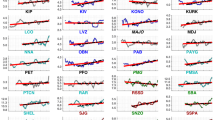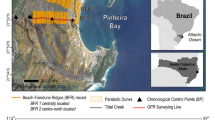Abstract
One possible consequence of a change in climate over the past several decades is an increase in wave heights, potentially threatening coastal areas as well as the marine industry1,2,3,4. But the difficulties in observing wave heights exacerbates a general problem of climate-change detection: inhomogeneities in long-term observational records owing to changes in the instruments or techniques used, which may cause artificial trends5,6. Ground movements with periods of 4–16 seconds, known as microseisms, are associated with ocean waves and coastal surf 7,8,9,10, and have been recorded continuously since the early days of seismology. Here we use such a 40-year record of wintertime microseisms from Hamburg, Germany, to reconstruct the wave climate in the northeast Atlantic Ocean. For the period 1954–77, we detect an average of seven days per month with strong microseismic activity, without a significant trend. This number increases significantly in the second half of the record, reaching approximately 14 days of strong microseisms per month. The implied increase in northeast Atlantic wave height over the past 20 years parallels increased surface air temperatures11 and storminess12 in this region, suggesting a common forcing.
This is a preview of subscription content, access via your institution
Access options
Subscribe to this journal
Receive 51 print issues and online access
$199.00 per year
only $3.90 per issue
Buy this article
- Purchase on Springer Link
- Instant access to full article PDF
Prices may be subject to local taxes which are calculated during checkout


Similar content being viewed by others
References
Carter, D. J. T. & Draper, L. Has the north-east Atlantic become rougher? Nature 332, 494 (1988).
Bouws, E., Jannick, D. & Komen, G. J. On increasing wave height in the North Atlantic Ocean. Bull. Am. Meteorol. Soc. 77, 2275–2277 (1996).
Bijl, W. Impact of wind climate change on the surge in the southern North Sea. Clim. Res. 8, 45–59 (1997).
WASA Group. Changing waves and storms in the Northeast Atlantic? Bull. Am. Meteorol. Soc. 79, 741–760 (1998).
Karl, T. R., Quayle, R. G. & Groisman, P. Y. Detecting climate variations and changes: new challenges for observing and data management systems. J. Clim. 6, 1481–1494 (1993).
Jones, P. D. in Analysis of Climate Variability (eds von Storch, H. & Navarra, A.) 53–76 (Springer, Berlin, 1995).
Wiechert, E. Discussion, Verhandlung der zweiten Internationalen Seismologischen Konferenz, Strasbourg. Gerlands Beitr. Geophysik 2, 41–43 (1904).
Gutenberg, B. Untersuchungen über die Bodenunruhe mit Perioden von 4–10 Sekunden in Europa. Veröff. Zentr. Bur. Int. Seismol. Assoz. 106 (1921).
Gutenberg, B. Microseisms and weather forecasting. J. Meteorol. 4, 21–28 (1947).
Hasselmann, K. Statistical analysis of the generation of microseisms. Rev. Geophys. 1, 177–210 (1963).
Jones, P. D., New, M., Parker, D. E., Martin, S. & Rigor, I. G. Surface air temperature and its changes over the past 150 years. Rev. Geophys. 37, 173–199 (1999).
Alexandersson, H., Smith, T., Iden, K. & Tuomenvirta, H. Long-term trend variations of the storm climate over NW Europe. Glob. Atmos. Ocean Sys. 6, 97–120 (1998).
Stouffer, R. J., Manabe, S. & Vinnikov, K. Y. Model assessment of the role of natural variability in recent global warming. Nature 367, 634–636 (1994).
Santer, B. D. et al. A search for human influences on the thermal structure of the atmosphere. Nature 382, 39–45 (1996).
Mann, M. E., Bradley, R. S. & Huges, M. K. Global-scale temperature patterns and climate forcing over the past six centuries. Nature 392, 779–787 (1998).
Tett, S. F. B., Stott, P. A., Allen, M. R., Ingram, W. J. I. & Mitchell, J. F. B. Causes of twentieth-century temperature change near the Earth's surface. Nature 399, 569–572 (1999).
Shindell, D. T., Miller, R. L., Schmidt, G. A. & Pandolfo, L. Simulation of recent northern winter climate trends by greenhouse-gas forcing. Nature 399, 452–455 (1999).
Rodwell, M. J., Rowell, D. P. & Folland, C. K. Oceanic forcing of the wintertime North Atlantic oscillation and European climate. Nature 399, 320–323 (1999).
Günther, H. et al. The wave climate of the Northeast Atlantic over the period 1955–1994: the WASA wave hindcast. Glob. Atmos. Ocean Sys. 6, 121–163 (1998).
Berz, G. Global warming and the insurance industry. Interdisciplinary Sci. Rev. 18, 120–125 (1993).
Berz, G. & Conrad, K. Stormy weather: the mounting wind-storm risk and consequences for the insurance industry. Eurodecision 12, 65–69 (1994).
Conrad, V. & Pollak, L. D. Methods in Climatology (Harvard Univ. Press, Cambridge, Massachusetts, 1962).
WASA Group. Comment on “Increases in Wave Heights over the North Atlantic: a review of the evidence and some implications for the naval architect” by N. Hogben. Trans. R. Inst. Naval Arch. 137, 107–110 (1994).
Essen, H.-H., Klussmann, J., Herber, R. & Grevemeyer, I. Do microseisms in Hamburg (Germany) reflect the wave climate of the North Atlantic? Germ. J. Hydrogr. 51, 33–45 (1999).
Darbyshire, J. Analysis of twenty microseism storms during the winter of 1987–1988 and comparison with wave hindcasts. Phys. Earth Planet. Int. 63, 181–195 (1990).
Longuet-Higgins, M. S. & Ursell, F. Sea waves and microseisms. Nature 162, 700 (1948).
Longuet-Higgins, M. S. A theory of the origin of microseisms. Phil. Trans. R. Soc. Lond. A 243, 1–35 (1950).
Bromirski, P. D., Flick, R. E. & Graham, N. Ocean wave height determined from inland seismometer data: Implications for investigating wave climate changes in the NE Pacific. J. Geophys. Res. 104, 20753–20766 (1999).
Bath, M. An Investigation of the Uppsala Microseisms (Institute of Meteorology, Royal Univ. Uppsala, Report No. 14, Uppsala, 1949).
Acknowledgements
We thank G. Spars for assistance in analysing the historical seismological records. This work benefited from support of the Deutsche Forschungsgemeinschaft for the SFB 512 “Cyclones and the North Atlantic Climate System”.
Author information
Authors and Affiliations
Corresponding author
Rights and permissions
About this article
Cite this article
Grevemeyer, I., Herber, R. & Essen, HH. Microseismological evidence for a changing wave climate in the northeast Atlantic Ocean. Nature 408, 349–352 (2000). https://doi.org/10.1038/35042558
Received:
Accepted:
Issue Date:
DOI: https://doi.org/10.1038/35042558
This article is cited by
-
Seismic noise wavelet-based entropy in Southern California
Journal of Seismology (2021)
-
Trends of Global Seismic Noise Properties in Connection to Irregularity of Earth’s Rotation
Pure and Applied Geophysics (2020)
-
Connection of Seismic Noise Properties in Japan and California with Irregularity of Earth’s Rotation
Pure and Applied Geophysics (2020)
-
Exploring the link between microseism and sea ice in Antarctica by using machine learning
Scientific Reports (2019)
-
Long-term variations of wind and wave conditions in the coastal regions of the Black Sea
Natural Hazards (2016)
Comments
By submitting a comment you agree to abide by our Terms and Community Guidelines. If you find something abusive or that does not comply with our terms or guidelines please flag it as inappropriate.



